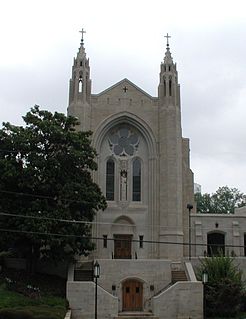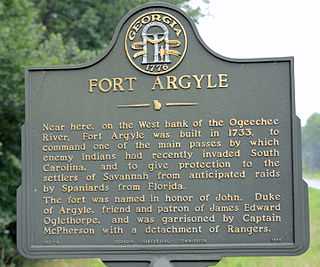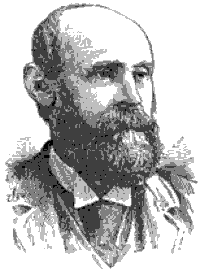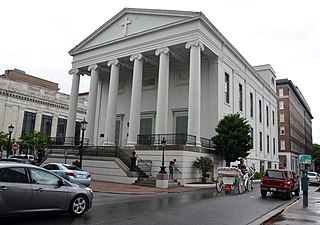
Savannah is the oldest city in the U.S. state of Georgia and is the county seat of Chatham County. Established in 1733 on the Savannah River, the city of Savannah became the British colonial capital of the Province of Georgia and later the first state capital of Georgia. A strategic port city in the American Revolution and during the American Civil War, Savannah is today an industrial center and an important Atlantic seaport. It is Georgia's fifth-largest city, with a 2019 estimated population of 144,464. The Savannah metropolitan area, Georgia's third-largest, had an estimated population of 393,353 in 2019.

Forsyth is a city in Monroe County, Georgia, United States. It is the county seat of Monroe County. The population was 3,788 at the 2010 census. Forsyth is part of the Macon Metropolitan Statistical Area.

The Archdiocese of Atlanta is a Latin Church ecclesiastical jurisdiction or archdiocese of the Catholic Church in the United States comprising portions of Georgia. Its ecclesiastical territory comprises Georgia's northern counties, including the capital of Atlanta. It is led by a prelate archbishop, who is also pastor of the mother church, the Cathedral of Christ the King in Atlanta. The Cathedral is the metropolitan see of the Catholic Ecclesiastical Province of Atlanta, which covers Georgia, South Carolina, and North Carolina. The archdiocese reported 102 parishes and missions, and 1,200,000 registered Catholics, as of 2020.

The Battle of Kettle Creek was the first major victory for Patriots in the back country of Georgia during the American Revolutionary War that took place on February 14, 1779. It was fought in Wilkes County about eight miles (13 km) from present-day Washington, Georgia. A militia force of Patriots decisively defeated and scattered a Loyalist militia force that was on its way to British-controlled Augusta.

Stephen Elliott was the 37th bishop of the Protestant Episcopal Church in the United States of America. He was the first Bishop of Georgia and Provisional Bishop of Florida. He was also the first and only Presiding Bishop of the Protestant Episcopal Church in the Confederate States of America.

The Episcopal Diocese of Georgia, USA is one of 20 dioceses that comprise Province IV of the US Episcopal Church, and is a diocese within the worldwide Anglican Communion. The current bishop is Frank S. Logue, who succeeded Scott Anson Benhase on May 30, 2020 when he was consecrated 11th Bishop of Georgia at a service held in Christ Church in Savannah, Georgia.

Ebenezer, also known as New Ebenezer, is a ghost town in Effingham County, Georgia, United States, along the banks of Ebenezer Creek. It was listed on the U.S. National Register of Historic Places as Ebenezer Townsite and Jerusalem Lutheran Church in 1974.

The Savannah Historic District is a large urban U.S. historic district that roughly corresponds to the pre-civil war city limits of Savannah, Georgia. The area was declared a National Historic Landmark District in 1966, and is one of the largest urban, community-wide historic preservation districts in the United States. The district was made in recognition of the Oglethorpe Plan, a unique sort of urban planning begun by James Oglethorpe at the city's founding and propagated for the first century of its growth.

Saint Paul's Church is a historic Episcopal church in downtown Augusta, Georgia, adjacent to Riverwalk Augusta. A member of the Episcopal Diocese of Georgia, Saint Paul's conducts its worship services using the 1979 Book of Common Prayer. The church, located on the corner of 6th and Reynolds Streets, is the oldest church congregation in Augusta. It was established in 1750 by the Church of England at the site of Fort Augusta. There have been five churches on the site. The current church building, which combines features of Federal architecture with those of the Georgian and Greek Revival styles, was designed by Henry Ten Eyck Wendell and dedicated in 1920. It can seat up to 600 people.

Thomas Albert Andrew Becker was an American prelate of the Roman Catholic Church. He served as the first bishop of the Diocese of Wilmington, Delaware (1868–86) and the sixth bishop of the Diocese of Savannah, Georgia (1886–99).

Augusta Downtown Historic District is a historic district that encompasses most of Downtown Augusta, Georgia and its pre-Civil War area.

Historic First Bryan Baptist Church is an African-American church that was organized in Savannah, Georgia, by Andrew Bryan in 1788. Considered to be the Mother Church of Black Baptist, the site was purchased in 1793 by Bryan, a former slave who had also purchased his freedom. The first structure was erected there in 1794. By 1800 the congregation was large enough to split: those at Bryan Street took the name of First African Baptist Church, and Second and Third African Baptist churches were also established. The current sanctuary of First Bryan Baptist Church was constructed in 1873.

Bruce & Morgan was an architectural firm in Georgia. It was a partnership during 1882 to 1904 of Alexander Bruce (1835-1927) and Thomas Henry Morgan (1857-1940.
The following is a timeline of the history of Savannah, Georgia, United States.

Old Fort Argyle Site is a historic site near Savannah. It is in Fort Stewart in Bryan County, Georgia. It was an English military settlement. It was added to the National Register of Historic Places on March 31, 1975. Access is restricted.

The Great Slave Auction was a March 2 and 3, 1859 auction of enslaved Africans held at Ten Broeck Race Course, near Savannah, Georgia, United States. Slaveholder and absentee plantation owner Pierce Mease Butler authorized the sale of approximately 436 men, women, children, and infants to be sold over the course of two days. The sale's proceeds went to satisfy Butler's significant debts, much of it from gambling. The auction is regarded as the largest single sale of enslaved people in U.S. history.
The following is a timeline of the history of the city of Augusta, Georgia, USA.

Alexander Campbell Bruce (1835–1927), also known as A. C. Bruce, was an American architect based in Atlanta, Georgia.

Christ Church is an Episcopal church at 28 Bull Street, Johnson Square, in Savannah, Georgia. Founded in 1733, it was the first church established in the Province of Georgia and one of the first parishes within the Episcopal Diocese of Georgia, earning it the nickname "the Mother Church of Georgia". The present church building was constructed in 1838 and is located in the Savannah Historic District.
Edward Nathaniel Packard Padelford was an American businessman, prominent in Savannah, Georgia. He was one of the city’s longest-serving merchants and most respected citizens, and was a board member of a large number of companies. At the time of his death, he was among the wealthiest of merchants in the American South.



















